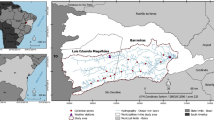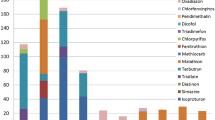Abstract
The aim of this study was the development of analytical methods for the simultaneous determination of 25 selected pharmaceuticals, metabolites, and pesticides, belonging to the various chemical classes, in river sediments and their corresponding surface and ground water with the purpose of monitoring the contamination levels. The methods were based on the solid-phase extraction as the sample preparation method for water samples, and the ultrasonic solvent extraction for the sediment samples, followed by the liquid chromatography–tandem mass spectrometry. High recoveries were achieved for extraction from both water and sediment samples for the majority of analytes. Low limits of detection were achieved for all investigated compounds in the water sample (1–5 ng L−1) as well as in the sediment (1–3 ng g−1). Applicability of the developed methods was demonstrated by determination of pharmaceutical and pesticide residues in 30 surface water, 44 groundwater, and 5 sediment samples from the Danube River Basin in Serbia. Sixty percent of target compounds were detected in environmental samples. The most frequently detected analytes in river sediments were the pesticides dimethoate and atrazine, while carbamazepine and metamizole metabolites 4-AAA and 4-FAA were the most frequently found in water samples.



Similar content being viewed by others
References
Beausse, J. (2004). Selected drugs in solid matrices: a review of environmental determination, occurrence and properties of principal substances. Trends in Analytical Chemistry, 23(10–11), 753–761.
Belmonte Vega, A., Garrido Frenich, A., & Martínez Vidal, J. L. (2005). Monitoring of pesticides in agricultural water and soil samples from Andalusia by liquid chromatography coupled to mass spectrometry. Analytica Chimica Acta, 538, 117–127.
Bu, Q., Wang, B., Huang, J., Deng, S., & Yu, G. (2013). Pharmaceuticals and personal care products in the aquatic environment in China: a review. Journal of Hazardous Materials, 262, 189–211.
Buchberger, W. W. (2007). Novel analytical procedures for screening of drug residues in water, waste water, sediment and sludge. Analytica Chimica Acta, 593, 129–139.
Chen, Y., Yu, G., Cao, Q., Zhang, H., Lin, Q., & Hong, Y. (2013). Occurrence and environmental implications of pharmaceuticals in Chinese municipal sewage sludge. Chemosphere, 93, 1765–1772.
Clara, M., Strenn, B., & Kreuzinger, N. (2004). Carbamazepine as a possible anthropogenic marker in the aquatic environment: investigations on the behaviour of carbamazepine in wastewater treatment and during groundwater infiltration. Water Research, 38, 947–954.
Commission of the European Communities. (2002). Towards a thematic strategy on the sustainable use of pesticides, Brussels. http://www.europarl.europa.eu/registre/docs_autres_institutions/commission_europeenne/com/2002/0349/COM_COM(2002)0349_EN.pdf. Accessed 19 Jul 2014.
Deshpande, A. D., Baheti, K. G., & Chatterjee, N. R. (2004). Degradation of β-lactam antibiotics. Current Science, 87(12), 1684–1695.
Dujaković, N., Grujić, S., Radišić, M., Vasiljević, T., & Laušević, M. (2010). Determination of pesticides in surface and ground waters by liquid chromatography–electrospray–tandem mass spectrometry. Analytica Chimica Acta, 678, 63–72.
El Beit, I. O. D., Wheelock, J. V., & Cotton, D. E. (1978). Factors influencing the degradation of dimethoate in soils and solutions. International Journal of Environmental Studies, 11, 253–260.
Farré, M., Picó, Y., & Barceló, D. (2014). Application of ultra-high pressure liquid chromatography linear ion-trap orbitrap to qualitative and quantitative assessment of pesticide residues. Journal of Chromatography A, 1328, 66–79.
Feldmann, D. F., Zuehlke, S., & Heberer, T. (2008). Occurrence, fate and assessment of polar metamizole (dipyrone) residues in hospital and municipal wastewater. Chemosphere, 71, 1754–1764.
Ferreira da Silva, B., Jelic, A., López-Serna, R., Mozeto, A. A., Petrovic, M., & Barceló, D. (2011). Occurrence and distribution of pharmaceuticals in surface water, suspended solids and sediments of the Ebro river basin, Spain. Chemosphere, 85, 1331–1339.
Ferrer, I., Hennion, M., & Barceló, D. (1997). Immunosorbents coupled on-line with liquid chromatography/atmospheric pressure chemical ionization/mass spectrometry for the part per trillion level determination of pesticides in sediments and natural waters using low preconcentration volumes. Analytical Chemistry, 69(22), 4508–4514.
Garcia-Ac, A., Segura, P. A., Viglino, L., Fürtös, A., Gagnon, C., Prévost, M., & Sauvé, S. (2009). On-line solid-phase extraction of large-volume injections coupled to liquid chromatography-tandem mass spectrometry for the quantitation and confirmation of 14 selected trace organic contaminants in drinking and surface water. Journal of Chromatography A, 1216, 8518–8527.
Ghanem, A., Bados, P., Perreau, F., Benabdallah, R., Plagellat, C., de Alencastro, L. F., & Einhorn, J. (2008). Multiresidue analysis of atrazine, diuron and their degradation products in sewage sludge by liquid chromatography tandem mass spectrometry. Analytical and Bioanalytical Chemistry, 391, 345–352.
Gómez, M. J., Sirtori, C., Mezcua, M., Fernández-Alba, A. R., & Agüera, A. (2008). Photodegradation study of three dipyrone metabolites in various water systems: identification and toxicity of their photodegradation products. Water Research, 42, 2698–2706.
Gómez, M. J., Gómez-Ramos, M. M., Malato, O., Mezcua, M., & Férnandez-Alba, A. R. (2010). Rapid automated screening, identification and quantification of organic micro-contaminants and their main transformation products in wastewater and river waters using liquid chromatography–quadrupole-time-of-flight mass spectrometry with an accurate-mass database. Journal of Chromatography A, 1217, 7038–7054.
Gros, M., Petrović, M., & Barceló, D. (2006). Development of a multi-residue analytical methodology based on liquid chromatography–tandem mass spectrometry (LC–MS/MS) for screening and trace level determination of pharmaceuticals in surface and wastewaters. Talanta, 70, 678–690.
Grujić, S., Vasiljević, T., & Laušević, M. (2009). Determination of multiple pharmaceutical classes in surface and ground waters by liquid chromatography–ion trap–tandem mass spectrometry. Journal of Chromatography A, 1216, 4989–5000.
Grujic, S., Vasiljevic, T., Radisic, M., & Lausevic, M. (2010). Determination of pesticides by matrix solid-phase dispersion and liquid chromatography–tandem mass spectrometry. In L. M. L. Nollet & H. S. Rathore (Eds.), Handbook of pesticides: methods of pesticide residues analysis (pp. 141–164). Boca Raton: CRC/Taylor & Francis Group.
Hörsing, M., Ledin, A., Grabic, R., Fick, J., Tysklind, M., la Cour Jansen, J., & Andersen, H. R. (2011). Determination of sorption of seventy-five pharmaceuticals in sewage sludge. Water Research, 45, 4470–4482.
Jones-Lepp, T. L. (2006). Chemical markers of human waste contamination: analysis of urobilin and pharmaceuticals in source waters. Journal of Environmental Monitoring, 8, 472–478.
Jørgensen, S. E., & Halling–Sørensen, B. (2000). Drugs in the environment. Chemosphere, 40, 691–699.
Köck-Schulmeyer, M., Olmos, M., López de Alda, M., & Barceló, D. (2013). Development of a multiresidue method for analysis of pesticides in sediments based on isotope dilution and liquid chromatography-electrospray–tandem mass spectrometry. Journal of Chromatography A, 1305, 176–187.
Kümmerer, K. (2001). Drugs in the environment: emission of drugs, diagnostic aids and disinfectants into wastewater by hospitals in relation to other sources—a review. Chemosphere, 45, 957–969.
Magnusson, M., Heimann, K., Ridd, M., & Negri, A. P. (2013). Pesticide contamination and phytotoxicity of sediment interstitial water to tropical benthic microalgae. Water Research, 47, 5211–5221.
Makihata, N., Kawamoto, T., & Teranishi, K. (2003). Simultaneous analysis of carbamate pesticides in tap and raw water by LC/ESI/MS. Analytical Sciences, 19, 543–549.
Martín, J., Santos, J. L., Aparicio, I., & Alonso, E. (2010). Multi-residue method for the analysis of pharmaceutical compounds in sewage sludge, compost and sediments by sonication-assisted extraction and LC determination. Journal of Separation Science, 33, 1760–1766.
Maurano, F., Guida, M., Melluso, G., & Sansone, G. (1997). Accumulation of pesticide residues in fishes and sediments in the River Sele (South Italy). Journal of Preventive Medicine and Hygiene, 38, 3–4.
Meffe, R., & de Bustamante, I. (2014). Emerging organic contaminants in surface water and groundwater: a first overview of the situation in Italy. Science of the Total Environment, 481, 280–295.
Moldovan, Z. (2006). Occurrences of pharmaceutical and personal care products as micropollutants in rivers from Romania. Chemosphere, 64, 1808–1817.
O’Brien, E., & Dietrich, D. R. (2004). Hindsight rather than foresight: reality versus the EU draft guideline on pharmaceuticals in the environment. Trends in Biotechnology, 22(7), 326–330.
Osenbrück, K., Gläser, H. R., Knöller, K., Weise, S. M., Möder, M., Wennrich, R., Schirmer, M., Reinstorf, F., Busch, W., & Strauch, G. (2007). Sources and transport of selected organic micropollutants in urban groundwater underlying the city of Halle (Saale), Germany. Water Research, 41, 3259–3270.
Petrovic, M., Farré, M., Lopez de Alda, M., Perez, S., Postigo, C., Köck, M., Radjenovic, J., Gros, M., & Barcelo, D. (2010). Recent trends in the liquid chromatography–mass spectrometry analysis of organic contaminants in environmental samples. Journal of Chromatography A, 1217, 4004–4017.
Radjenović, J., Jelić, A., Petrović, M., & Barceló, D. (2009). Determination of pharmaceuticals in sewage sludge by pressurized liquid extraction (PLE) coupled to liquid chromatography–tandem mass spectrometry (LC–MS/MS). Analytical and Bioanalytical Chemistry, 393, 1685–1695.
Ternes, T. A. (2001). Analytical methods for the determination of pharmaceuticals in aqueous environmental samples. Trends in Analytical Chemistry, 20(8), 419–434.
Ternes, T. A., Meisenheimer, M., McDowell, D., Sacher, F., Brauch, H. J., Haist-Gulde, B., Preuss, G., Wilme, U., & Zulei-Seibert, N. (2002). Removal of pharmaceuticals during drinking water treatment. Environmental Science & Technology, 36(17), 3855–3863.
Togola, A., Baran, N., & Coureau, C. (2014). Advantages of online SPE coupled with UPLC/MS/MS for determining the fate of pesticides and pharmaceutical compounds. Analytical and Bioanalytical Chemistry, 406, 1181–1191.
Trevors, J. T. (1996). Sterilization and inhibition of microbial activity in soil. Journal of Microbiological Methods, 26, 53–59.
UNEP/UN-HABITAT (2010). Sick water? The central role of wastewater management in sustainable development. http://www.grida.no/publications/rr/sickwater/. Accessed 19 Jul 2014.
Van De Steene, J. C., Stove, C. P., & Lambert, W. E. (2010). A field study on 8 pharmaceuticals and 1 pesticide in Belgium: removal rates in waste water treatment plants and occurrence in surface water. Science of the Total Environment, 408, 3448–3453.
Vazguez-Roig, P., Segarra, R., Blasco, C., Andreu, V., & Picó, Y. (2010). Determination of pharmaceuticals in soils and sediments by pressurizes liquid extraction and liquid chromatography tandem mass spectrometry. Journal of Chromatography A, 1217, 2471–2483.
Vazguez-Roig, P., Andreu, V., Onghen, M., Blasco, C., & Picó, Y. (2011). Assessment of the occurrence and distribution of pharmaceuticals in a Mediterranean wetland (L’Albufera, Valencia, Spain) by LC-MS/MS. Analytical and Bioanalytical Chemistry, 400, 1287–1301.
Vazguez-Roig, P., Andreu, V., Blasco, C., & Picó, Y. (2012). Risk assessment on the presence of pharmaceuticals in sediments, soils and waters of the Pego–Oliva Marshlands (Valencia, eastern Spain). Science of the Total Environment, 440, 24–32.
Wiegel, S., Aulinger, A., Brockmeyer, R., Harms, H., Löffler, J., Reincke, H., Schmidt, R., Stachel, B., von Tümpling, W., & Wanke, A. (2004). Pharmaceuticals in the river Elbe and its tributaries. Chemosphere, 57, 107–126.
Wille, K., De Brabander, H. F., De Wulf, E., Van Caeter, P., Janssen, C. R., & Vanhaecke, L. (2012). Coupled chromatographic and mass-spectrometric techniques for the analysis of emerging pollutants in the aquatic environment. Trends in Analytical Chemistry, 35, 87–108.
Yang, J. F., Ying, G. G., Zhao, J. L., Tao, R., Su, H. C., & Chen, F. (2010). Simultaneous determination of four classes of antibiotics in sediments of the pearl rivers using RRLC–MS/MS. Science of the Total Environment, 408, 3424–3432.
Zhou, J., & Broodbank, N. (2014). Sediment-water interactions of pharmaceutical residues in the river environment. Water Research, 48, 61–70.
Zuehlke, S., Duennbier, U., & Heberer, T. (2004). Determination of polar drug residues in sewage and surface water applying liquid chromatography-tandem mass spectrometry. Analytical Chemistry, 76(22), 6548–6554.
Acknowledgments
This work was supported by the Ministry of Education, Science and Technological Development of the Republic of Serbia (Projects ON172007 and TR37014).
Author information
Authors and Affiliations
Corresponding author
Rights and permissions
About this article
Cite this article
Radović, T., Grujić, S., Petković, A. et al. Determination of pharmaceuticals and pesticides in river sediments and corresponding surface and ground water in the Danube River and tributaries in Serbia. Environ Monit Assess 187, 4092 (2015). https://doi.org/10.1007/s10661-014-4092-z
Received:
Accepted:
Published:
DOI: https://doi.org/10.1007/s10661-014-4092-z




